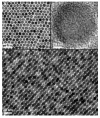Superparamagnetic Nanoparticles for Atherosclerosis Imaging
- PMID: 28344230
- PMCID: PMC5304673
- DOI: 10.3390/nano4020408
Superparamagnetic Nanoparticles for Atherosclerosis Imaging
Abstract
The production of magnetic nanoparticles of utmost quality for biomedical imaging requires several steps, from the synthesis of highly crystalline magnetic cores to the attachment of the different molecules on the surface. This last step probably plays the key role in the production of clinically useful nanomaterials. The attachment of the different biomolecules should be performed in a defined and controlled fashion, avoiding the random adsorption of the components that could lead to undesirable byproducts and ill-characterized surface composition. In this work, we review the process of creating new magnetic nanomaterials for imaging, particularly for the detection of atherosclerotic plaque, in vivo. Our focus will be in the different biofunctionalization techniques that we and several other groups have recently developed. Magnetic nanomaterial functionalization should be performed by chemoselective techniques. This approach will facilitate the application of these nanomaterials in the clinic, not as an exception, but as any other pharmacological compound.
Keywords: atherosclerosis plaque; cardiovascular imaging; chemoselective functionalization; iron oxide nanoparticles.
Conflict of interest statement
The authors declare no conflict of interest.
Figures









References
Publication types
LinkOut - more resources
Full Text Sources
Other Literature Sources

